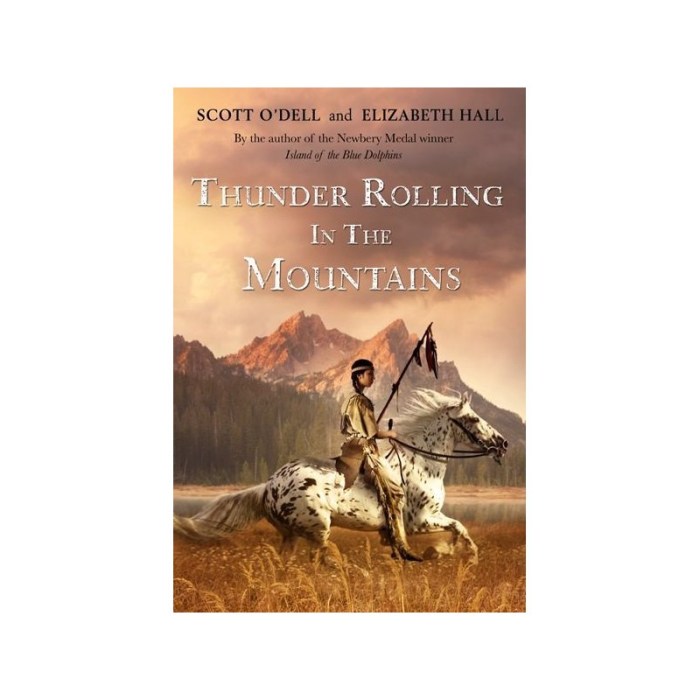Thunder Rolling in the Mountains PDF unveils the captivating story of thunder, a natural phenomenon that reverberates through the mountain landscape, leaving an unforgettable imprint on the human experience. From its scientific origins to its profound cultural and artistic significance, this comprehensive guide explores the awe-inspiring majesty of thunder.
Unveiling the secrets behind thunder’s rumbling echoes, this guide delves into the intricate interplay of lightning and sound waves, unraveling the science that orchestrates this natural symphony. It delves into the cultural tapestry woven around thunder, tracing its presence in ancient myths, folklore, and modern-day narratives.
1. Thunder Rolling in the Mountains
Setting and Atmosphere

Nestled amidst towering peaks and rugged landscapes, the mountains exude an aura of grandeur and awe. As the storm approaches, the sky darkens, casting an ominous veil over the terrain. Jagged peaks pierce through the gathering clouds, their silhouettes etched against the canvas of lightning flashes.
The air crackles with anticipation as the rumble of thunder reverberates through the valleys, signaling the arrival of a meteorological spectacle.
1.1 The Imposing Mountain Landscape
The mountains stand as formidable guardians, their steep slopes and sheer cliffs creating a sense of both wonder and trepidation. Jagged outcroppings and deep ravines form a labyrinthine network, adding to the rugged beauty of the terrain. The towering heights of the peaks dwarf all who venture near, instilling a profound respect for the untamed wilderness.
1.2 The Gathering Storm
The storm gathers momentum, its presence heralded by the darkening sky and flashes of lightning. The wind howls through the mountain passes, carrying with it the scent of rain and the promise of a tempest. The clouds swirl and churn, forming an ominous canopy overhead.
The air becomes heavy with anticipation, as the first rumbles of thunder echo through the mountains.
2. The Power and Majesty of Thunder
Thunder, the awe-inspiring companion of lightning, is a testament to the immense power of nature. It is the result of a sudden release of energy, created when the superheated air surrounding a lightning bolt rapidly expands. This expansion generates a shock wave that travels through the atmosphere, producing the characteristic rumble we hear as thunder.
2.1 Cultural Significance of Thunder, Thunder rolling in the mountains pdf
Throughout history, thunder has held a profound cultural significance. In many ancient myths and legends, it was seen as a manifestation of divine power or a warning from the heavens. In some cultures, it was believed to be the voice of the gods, while in others it was associated with the wrath of spirits or supernatural beings.
2.2 Anecdotes and Examples
The impact of thunder on humans is both awe-inspiring and humbling. Its sudden and deafening roar can startle even the most seasoned hiker or climber. The sound can penetrate deep into the soul, leaving an imprint that lingers long after the storm has passed.
In some cases, thunder has been known to trigger profound emotional responses, ranging from fear and trepidation to a sense of awe and wonder.
3. Echoes and Reverberations
As thunder rolls through the mountains, it creates a symphony of sound that reverberates through the valleys and echoes off the sheer rock faces. The duration and intensity of these reverberations depend on a number of factors, including the topography of the terrain, the distance from the lightning strike, and the atmospheric conditions.
3.1 Metaphorical and Poetic Implications
The echoes of thunder have often been used as a metaphor for the passage of time or the reverberations of past events. In literature and poetry, thunder has been used to symbolize both the destructive and the creative forces of nature, as well as the power of memory and the echoes of the past that continue to shape the present.
4. The Influence on Nature
Thunderstorms play a vital role in the mountain ecosystem. The heavy rainfall can replenish water sources, while the lightning strikes can trigger wildfires that clear dead vegetation and promote new growth. The thunder and lightning can also affect wildlife, startling animals and causing them to seek shelter.
4.1 Impact on Wildlife and Vegetation
The sudden and deafening roar of thunder can startle wildlife, causing them to scatter for cover. Birds may take flight, while animals on the ground may seek refuge in caves or under dense vegetation. The heavy rainfall associated with thunderstorms can also impact wildlife, providing a source of water for animals in dry areas.
4.2 Role in the Water Cycle
Thunderstorms are an important part of the water cycle in mountainous regions. The heavy rainfall can replenish water sources, such as lakes, rivers, and streams. This water is essential for both human populations and wildlife, and it also helps to regulate the temperature and humidity of the environment.
4.3 Shaping the Landscape
Over time, thunderstorms can shape the landscape of mountainous regions. The heavy rainfall can cause erosion, which can lead to the formation of new gullies and ravines. The lightning strikes can also trigger wildfires, which can burn away vegetation and expose the underlying rock.
These processes can create a rugged and dynamic landscape that is constantly evolving.
5. Artistic and Literary Interpretations
Thunder has been a source of inspiration for artists and writers throughout history. Its power and majesty have been captured in paintings, sculptures, music, and literature. In art, thunder has often been depicted as a symbol of divine power or as a force of nature that is both awe-inspiring and terrifying.
5.1 Depictions in Art and Music
In music, thunder has been used to create a sense of drama and excitement. Composers such as Beethoven and Wagner have used thunder to evoke the power and majesty of nature. In literature, thunder has been used to create a sense of atmosphere and to symbolize both the destructive and the creative forces of nature.
5.2 Symbolism and Emotions
In art and literature, thunder is often used as a symbol of divine power or as a force of nature that is both awe-inspiring and terrifying. It can also be used to symbolize the power of memory and the echoes of the past that continue to shape the present.
6. Safety and Preparedness

While it is important to appreciate the beauty and power of thunder, it is also important to be aware of the risks associated with thunderstorms. Lightning is a dangerous phenomenon that can cause serious injury or death. It is important to take precautions when thunderstorms are in the area.
6.1 Guidelines for Staying Safe
When thunderstorms are in the area, it is important to seek shelter in a sturdy building. If you are caught outside, avoid open areas, tall trees, and metal objects. If you hear thunder, it is important to seek shelter immediately.
Lightning can strike up to 10 miles away from the thunderstorm, so it is important to take precautions even if the storm is not directly overhead.
6.2 Risks Associated with Thunderstorms
In addition to lightning, thunderstorms can also bring other hazards, such as flooding, hail, and wind. It is important to be aware of these hazards and to take precautions to stay safe. If you are in a flood-prone area, it is important to be prepared to evacuate.
If you are caught in a hail storm, it is important to seek shelter in a sturdy building. If you are caught in a wind storm, it is important to stay away from windows and doors.
User Queries: Thunder Rolling In The Mountains Pdf
What is the scientific explanation behind thunder?
Thunder is the sound produced by the rapid expansion of air heated by lightning. As lightning strikes, it creates a channel of extremely hot air that expands outward at supersonic speeds, generating a shock wave that manifests as thunder.
How does thunder affect the mountain ecosystem?
Thunder plays a crucial role in the mountain ecosystem by triggering rainfall, which replenishes water sources and supports plant growth. It also influences wildlife behavior, providing a cue for animals to seek shelter or adjust their foraging patterns.
What are the safety precautions to consider during thunderstorms in mountainous areas?
To ensure safety during thunderstorms, it is essential to seek shelter indoors or in a hard-top vehicle. Avoid open areas, tall objects, and bodies of water. Stay informed about weather forecasts and be prepared to adjust plans if necessary.